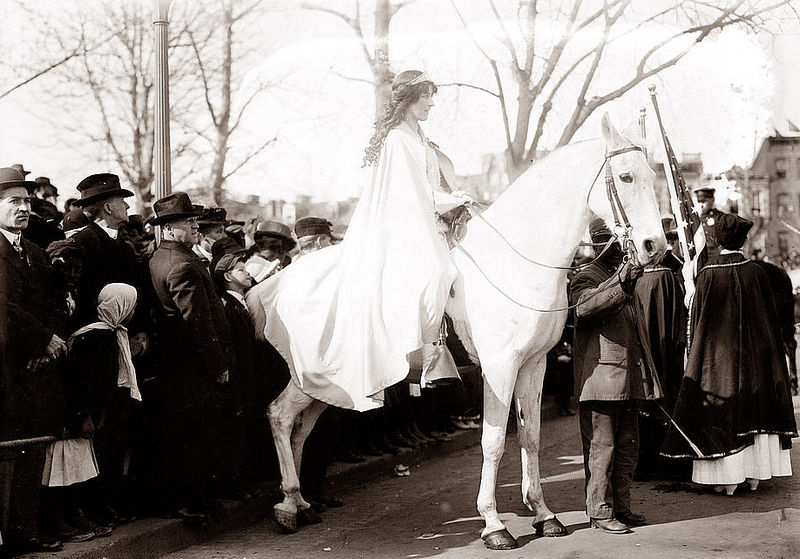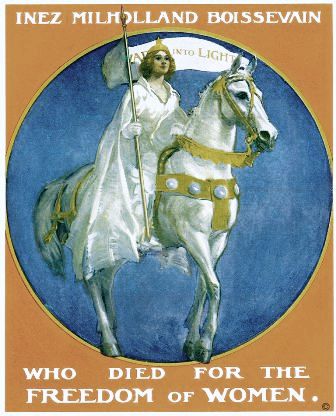Trailer for Inez Milholland short documentary, Inez Milholland: Forward into Light (2016). Directed by Martha Wheelock.
Her last public words were, "Mr. President, how long must women wait for liberty?" Her lasting public image was that of a beauty on a white horse leading the march for women's voting rights. Athlete, attorney, W.W. I news correspondent, Inez Milholland Boissevain's brief but spectacular life would impact the women's movement long after her death.
Inez Milholland grew up in Brooklyn, NY. Her father, John Milholland, was a journalist and inventor who, when Inez was a child, sold a message-carrying system that made the family rich. But although Inez grew up with wealth, she also grew up with a social conscience. She'd go on to spend her life fighting for fairness and equality, a champion of the underdog.

Inez Milholland leads 1913 Woman Suffrage Procession in Washington, D.C.
Bain Reporting, Library of Congress Archives [Public Domain] via Flickr
After attending schools in various European countries, Inez Milholland enrolled at Vassar College. There she starred in plays, set records in track and field, and found her voice as a political upstart. When the college refused to allow speakers on women's suffrage to appear on campus, Inez was outraged. She took action, organizing an impromptu rally in the cemetery next door so that the speakers could be heard. By the time Inez Milholland graduated, two-thirds of the student body belonged to the women's suffrage group she'd created. From Vassar, it was on to New York University where she earned a law degree, specializing in labor law. Again, Inez Milholland set out to fight for the underdog.
 Suffrage Poster
Suffrage Poster
Schlesinger Library, RIAS, Harvard University / No restrictions via Wikimedia
Though her caseload as a labor lawyer was enormous, Inez also became involved in many social causes, working with such groups as the Women's Trade Union League, the National Association for the Advancement of Colored People, and, of course, the women's suffrage movement. Beautiful, witty and dynamic, Inez was an excellent speaker and drew quite a crowd. These qualities also drew quite a few suitors, and before her 1913 marriage to Dutch businessman Jan Boissevain, she was romantically linked to such notables as political activist Max Eastman and radio inventor Guglielmo Marconi. Inez Milholland Boissevain was becoming well known in many political circles, but it was the stunt she pulled next that would gain her national notoriety.
Inez Milholland
Davis & Eickemeyer; Rudolf Eickemeyer, Jr. / Library of Congress Archives [Public Domain] via wikimedia
On March 13, 1913, the day of Woodrow Wilson's presidential inauguration, 8,000 suffragettes descended upon Washington to march for their cause. There, at the head of the parade, draped in robes, riding a huge white horse, and looking startlingly beautiful, was Inez Boissevain. She and her fellow suffragettes were insulted, spat upon, and, in some cases, physically assaulted. But they marched on, determined to gain support for their cause. Their efforts were in vain. Woodrow Wilson took office and essentially ignored the women's suffrage question. It was during a speech against Woodrow Wilson that Inez Milholland Boissevain suddenly collapsed, sick with pernicious anemia. She knew she had the potentially deadly disease and should rest, but she could not. She had to keep fighting for her cause. Ten weeks after her collapse, she died. She was 30 years old. In 1920, four years after Inez Milholland's death, Congress ratified the 19th amendment, which granted women the right to vote.
Page created on 8/24/2011 11:55:27 PM
Last edited 8/3/2020 7:27:37 AM
